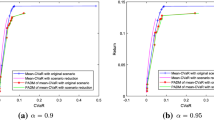Abstract
Scenario approach is a widely used tool in portfolio risk management, however, it often runs into dilemma when determining the distribution of asset returns with insufficient information, which will be used to simulate the scenarios. Also the quality of generated scenarios are not guaranteed even when the distribution of asset returns is known exactly. A set-valued scenario approach was proposed by Zhu, et al. (2015) as a possible remedy. As a necessary supplement of the results proposed by Zhu, et al. (2015), this paper theoretically investigates the convergent property of the numerical solution based on the set-valued scenario approach under the condition that the underlying distribution is known.
Similar content being viewed by others
References
Markowitz H M, Portfolio selection, Journal of Finance, 1952, 7: 77–91.
Markowitz H M, Portfolio Selection: Efficient Diversification of Investments, John Wiley & Sons, New York, 1959.
Bawa V S and Lindenberg E B, Capital market equilibrium in a mean-lower partial moment framework, Journal of Financial Economics, 1977, 5: 189–200.
Fishburn P C, Mean-risk analysis with risk associated with below-target returns, American Economic Review, 1977, 67: 116–126.
Morgan J P, RiskMetrics™, Technical Document, 4th Edition, 1996.
Pflug G, Some remarks on the value-at-risk and the conditional value-at-risk, Probabilistic Constrained Optimization: Methodology and Applications, Ed. by Uryasev S, Kluwer Academic Publishers, Dordrecht, 2000.
Rockafellar R T and Uryasev S, Optimization of conditional Value-at-Risk, Journal of Risk, 2000, 2: 21–41.
Rockafellar R T and Uryasev S, Conditional Value-at-Risk for general loss distributions, Journal of Banking and Finance, 2002, 26: 1443–1471.
Shapiro A, Quantitative stability in stochastic programming, Mathematical Programming, 1994, 67: 99–108.
Shapiro A and Homen-De-Mello T, On the rate of convergence of optimal solutions of Monte Carlo approximations of stochastic programs, SIAM Journal on Optimization, 2000, 11: 70–86.
Costa O L V and Paiva A C, Robust portfolio selection using linear-matrix inequality, Journal of Economic Dynamics & Control, 2002, 26: 889–909.
Goldfarb D and Iyengar G, Robust portfolio selection problems, Mathematics of Operations Research, 2003, 28: 1–38.
Halldórsson B V and Tütüncü R H, An interior-point method for a class of saddle-point problems, Journal of Optimization Theory and Applications, 2003, 116: 559–590.
Garlappi L, Uppal R, and Wang T, Portfolio selection with parameter and model uncertainty: A multi-prior Approach, Review of Financial Studies, 2007, 20: 41–81.
Lu Z S, Robust portfolio selection based on joint ellipsoidal uncertainty set, Optimization Methods & Software, 2011, 26: 89–104.
El Ghaoui L, Oks M, and Oustry F, Worst-case Value-at-Risk and robust portfolio optimization: A conic programming approach, Operations Research, 2003, 51: 543–556.
Natarajan K, Pachamanova D, and Sim M, Incorporating asymmetric distributional information in robust Value-at-Risk optimization, Management Science, 2008, 54: 573–585.
Zhu S S and Fukushima M, Worst-case conditional Value-at-Risk with application to robust portfolio management, Operations Research, 2009, 57: 1155–1168.
Zhu S S, Li D, and Wang S Y, Robust portfolio selection under downside risk measures, Quantitative Finance, 2009, 9: 869–885.
Fabozzi F J, Huang D S, and Zhou G F, Robust portfolios: Contributions from operations resdearch and finance, Annals of Operations Research, 2010, 176: 191–220.
Fabozzi F J, Kolm P N, Pachamanova D, et al., Robust Portfolio Optimization and Management, John Wiley & Sons, Hoboken, NJ, 2007.
Zhu S S, Ji X D, and Li D, A robust set-valued scenario approach for handling modeling risk in portfolio optimization, Journal of Computational Finance, 2015, 19: 11–40.
Sturm J, Using SeDuMi, a Matlab toolbox for optimization over symmetric cones, Department of Ecnometrics, Tilburg University, The Netherlands, 2001.
Author information
Authors and Affiliations
Corresponding author
Additional information
This research was partially supported by the National Natural Science Foundation of China under Grant Nos. 71471180, 61170107, 71571062, and the National Natural Science Foundation of Hebei Normal University under Grant No. L2011Z12.
This paper was recommended for publication by Editor ZHANG Xun.
Rights and permissions
About this article
Cite this article
Ji, X., Zhu, S. The convergence of set-valued scenario approach for downside risk minimization. J Syst Sci Complex 29, 722–735 (2016). https://doi.org/10.1007/s11424-016-5028-1
Received:
Revised:
Published:
Issue Date:
DOI: https://doi.org/10.1007/s11424-016-5028-1




